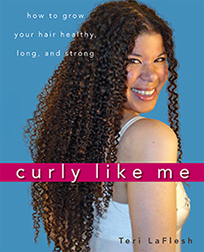
Available now!
Curly Like Me, the off-the-grid, do-it yourself owner's manual for tightly curly hair, is ready for ordering. Grab your copy today!

Every purchase made from
this site (through Amazon)
helps support it — and it
doesn't cost you anything
extra.
|
|
In the ingredient descriptions: Good means that I like to see this in a product's list of ingredients. Okay means this product appears safe for a curly person like me to use. Caution means that this ingredient may not be good in some hair care products, or for some people. Avoid means this ingredient may hurt your hair. If you see this ingredient in a hair product, it's best to put it down and walk away.
|
|
| |
Lanolin
(aka Wool wax; Wool grease; Wool fat)
Okay
Lanolin is a refined emollient wax (not technically an oil) that comes from the oil glands of sheep that is similar to the oil from human oil glands. Used in lots of products from makeup, eye creams and hair products. Lanolin contains about 30% water, so it is often used to keep skin moisturized by preventing water loss from it. It is also used for keeping the oil and water components in products from separating.
Advertisers have found that putting it in products sells them, often claiming it works better than other oils, but there is little scientific proof this is true. However, for sensitive skin, it may cause allergic reaction such as rashes or breakouts. Otherwise, it is an excellent moisturizer for hair and skin, second in preventing water loss only to petrolatum, according to one study. However, in rinse-off products, this does not apply since the lanolin is being washed off.
Lanolin is a pale yellow and is insoluble in water, though, interestingly, it can absorb nearly twice its own weight in water. It is soluble in oil. It has a distinctive scent and can be sticky and hard to spread [Winter (7th ed) pgs 319-320; Hunting (Conditioning) pgs 259-260].
Source(s):
Winter Hunting
|
|
|
Lanolin Oil
(aka Liquid lanolin; Dewaxed lanolin)
Okay
Lanolin oil is made by removing from the normally waxy lanolin its solid components. Found in many cosmetics, skin products, soaps, moisturizers, and hair products. Its used as an emollient that works well with hair and skin. The advantage it has over Lanolin is that it is less sticky, and spreads more smoothly [Winter (7th ed) pg 320; Hunting (Conditioning) pg 264].
Lanolin oil is a clear yellowish liquid with a distinct scent. It is insoluble in water.
See also:
Lanolin
Source(s):
Hunting Winter
|
Lanolin wax
Okay
Lends thicker texture to styling products. Can be sticky and leave a “coated feeling”. Pg 372.
Source(s):
Begoun
|
|
References:
Applewhite, Thomas H., ed. Proceedings of the World Conference on Lauric Oils: Sources, Processing, and Applications
AOCS Publishing, 1994.
Barel, André O., Marc Paye, and Howard I. Maibach., eds. Handbook of Cosmetic Science and Technology, Second Edition
Marcel Dekker, Inc., 2001.
Begoun, Paula. Don’t Go Shopping for Hair-Care Products Without Me. 3rd Edition.
Renton: Beginning Press, 2005.
Begoun, Paula. The Beauty Bible.
Renton: Beginning Press, 2002.
Begoun, Paula. Don’t Go to the Cosmetics Counter Without Me.
Renton: Beginning Press, 2003.
Bellum, Sarah, ed. The Beauty Brains: Real Scientists Answer Your Beauty Questions
New York: Brains Publishing, 2008.
Gottschalk, Tari E. and McEwen, Gerald N, Jr. PhD, eds. International Cosmetic Ingredient Dictionary and Handbook, Tenth Edition 2004, Volumes 1-4.
Washington D. C.: The Cosmetic, Toiletry, and Fragance Association, 2004.
Halal, John Hair Structure and Chemistry Simplified, Fifth Edition
Albany: Milady, 2002.
Hunting, Anthony L.L. Encyclopedia of Conditioning Rinse Ingredients.
Cranford, NJ: Micelle Press, Inc., 1987.
Hunting, Anthony L.L. Encyclopedia of Shampoo Ingredients.
Cranford, NJ: Micelle Press, Inc., 1983.
Johnson, Dale H. (Ed.). Hair and Hair Care, Cosmetic Science and Technology Series. Vol. 17.
New York: Marcel Dekker, 1997. Print.
Nnanna, Ifendu A. and Jiding Xia., eds. Protein-Based Surfactants: Synthesis: Physicochemical Properties, and Applications (Surfactant Science)
Madison Heights: CRC, 2001.
Quadflieg, Jutta Maria. Fundamental properties of Afro-American hair as related to their straightening/relaxing behaviour.
Diss. U of Rheinisch-Westfälischen Technischen Hochschule Aachen, 2003.
Schueller, Randy and Perry Romanowski, eds. Conditioning Agents for Hair and Skin.
New York: Marcel Dekker, Inc., 1999.
Winter, Ruth M.S. A Consumer's Dictionary of Cosmetic Ingredients: Complete Information About the Harmful and Desirable Ingredients Found in Cosmetics and Cosmeceuticals
New York: Three Rivers Press, 2005.
Zviak, Charles., ed. The Science of Hair Care (Dermatology)
New York: Marcel Dekker, Inc., 1986.
|
|